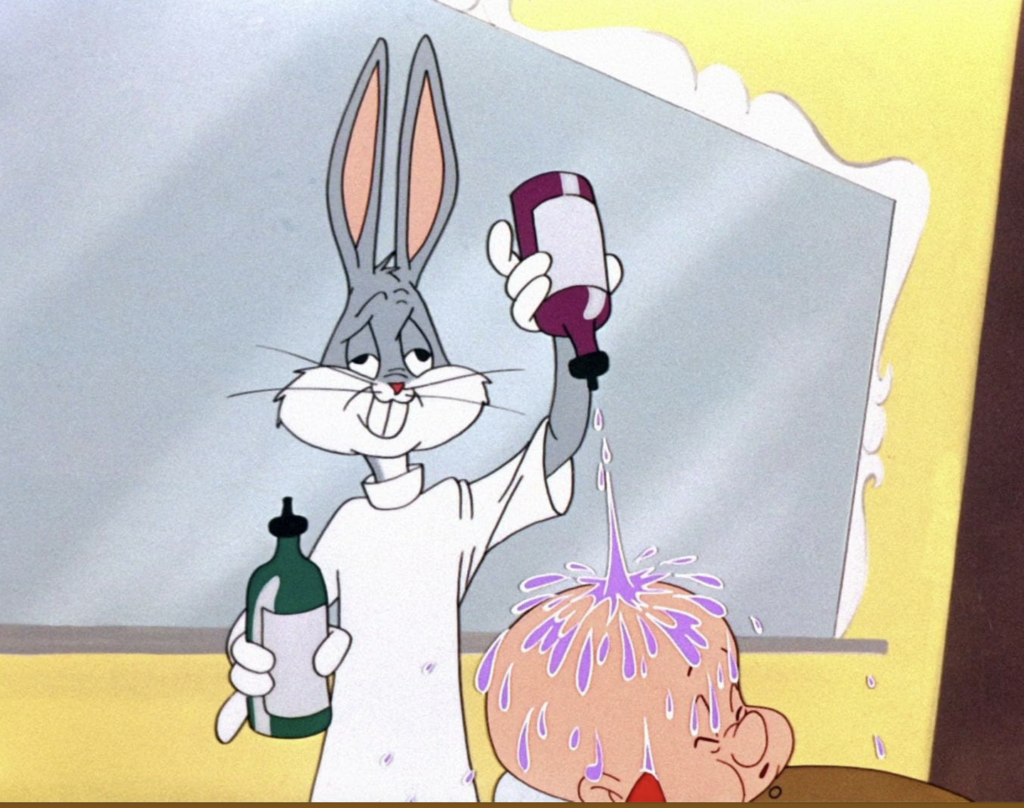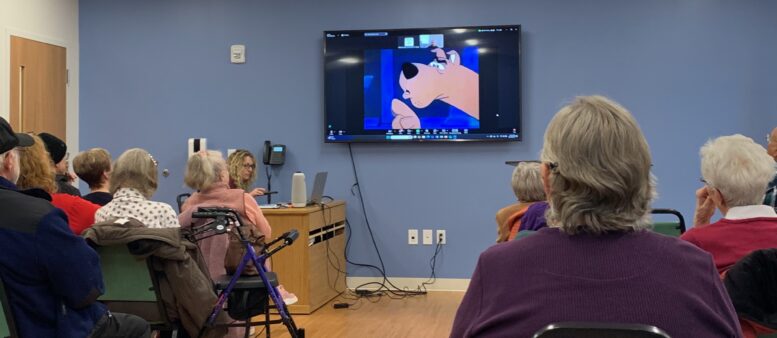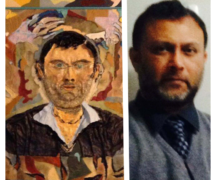By JULIE CARLE
BG Independent News
Sitting in front of the television set with a bowl of cold cereal and watching four hours of Saturday morning cartoons is a common childhood memory for many adults.
Marty Gitlin tapped into those sentimentalities during a recent program at the Wood County Senior Center. There, he transported a roomful of adults back to those bygone days of watching Bugs Bunny, Mickey Mouse and other cartoon favorites.
“I remember Saturday mornings; I got so excited growing up in the ’60s, waking up to watch two hours of Warner Brothers cartoons,” said the co-author of the book, “A Celebration of Animation: The 100 Greatest Cartoon Characters in Television History.” He recalled watching Bugs Bunny, Daffy Duck, Porky Pig and Foghorn Leghorn before tuning into Hanna-Barbera’s Woody Woodpecker, Tom and Jerry, and The Flintstones.
Animated cartoons have endured since the first “talkies” in 1928 to current-day cartoons that have become more socially conscious.
Walt Disney’s “Steamboat Willie,” which introduced Mickey Mouse in November 1928, is often considered the first animated cartoon. However, Paul Terry Studios’ “Dinner Time,” about a pack of dogs that takes over a butcher shop by running away with the shop, was released a month ahead of the Disney production.
“Dinner Time” was not successful with audiences in 1928. When Gitlin showed the nearly six-minute film, there were plenty of laughs at the silly antics of the dogs, dog catcher and butcher.
Despite Mickey Mouse’s longevity, Gitlin and co-author Joseph Wos ranked the Disney mouse #28 in the book.
“We used different criteria to rank the characters, like legacy, how long they remained in the world or American consciousness; their personalities, if they were funny, superheroes, evil; how much impact they had in the shows; and their unique voices,” Gitlin said.
When Mickey Mouse came to television in the 1950s on the Mickey Mouse Club, Donald Duck was considered a superior character who was more popular with kids, had a better personality and more depth.
“Walt wanted Mickey Mouse to be the face of his organization, so he didn’t expand his personality during that time,” Gitlin explained.
Popeye the Sailor Man, who ranked #11 in the book, started as a comic strip character before he became an animated cartoon. He was created before Mickey Mouse was introduced, Gitlin said as he shared an early Popeye cartoon.
The clip had the crowd laughing out loud as Popeye and Bluto (who was briefly known as Brutus during the 1950s) battled to wash the windows of their mutual love interest, Olive Oil.
“At 6-foot 4 inches and 20 pounds, she was the skinniest character that I never considered to be particularly attractive,” he said, but the two characters did everything in their power to win her over.
In the 1940s and after, various animation studios were jealous of Warner Brothers’ success.
“They were the king of animation with Bugs, Porky, Daffy, and a whole host of wonderful characters,” he said. They tried to hire some of Warner Brothers’ animators to create characters.
Legendary animator Tex Avery created Screwy Squirrel for MGM, which moved into animation during World War II.
Ben “Bugsy” Hardaway (who created Bugs Bunny for Warner Brothers) was hired to create “a wacky, crazy character like Bugs Bunny” for the Walter Lantz Studio.
“And he did,” Gitlin said. “He created the most popular cartoon character for Walter Lantz Studio by far in Woody Woodpecker (#22).”
Hardaway’s Bugs Bunny is ranked #1 in the book.
“One of the things that made him so great was he never picked on other cartoon characters,” Gitlin said. “He was picked on and then would fight back in imaginative ways, which allowed him to play off other cartoon characters such as Daffy Duck, Elmer Fudd, and my personal favorite, Yosemite Sam,” who earned the #26 spot in the book.
Yosemite Sam was “so wacky and so out there,” he added.
Gitlin also pointed out that because of Bugs Bunny, many people’s first experience with classical music, including his, was with Bugs Bunny cartoons. The most memorable one was “The Rabbit of Seville,” a takeoff on the opera “The Barber of Seville.”
“I did a program in Seville, Ohio, and saw Joe’s Barbershop and wanted to ask him why he didn’t name his barbershop “The Barber of Seville,” Gitlin joked.

The music and the sound didn’t come through very well when he showed the barber cartoon, but Bugs Bunny’s antics with Elmer Fudd in the barber chair were hilarious.
Cartoons moved to television in the late 1950s and early 1960s. Because the animators had to work a lot faster, the animation suffered.
“They didn’t have time to put as much depth into the animation,” he said. “But that doesn’t mean there weren’t a lot of great cartoon characters on television.”
Among the greatest simply drawn cartoons were “Beany and Cecil” (#46) and another of his favorites, Bullwinkle (#7) from “Rocky and Bullwinkle.”
“The Flintstones” was the first prime-time cartoon show that included laugh tracks, he said. Based on the popular 1950s sitcom “The Honeymooners,” Fred Flintstone (#14) was Ralph Cramden reincarnated and Barney Rubble, who was voiced by Mel Blanc, was Ed Norton’s character.
The Flintstones clip had Fred showing Barney how to pick up a 7-10 split in the bowling alley. With Fred’s memorable twinkling toes, he said, “Keep your eye on the ball, Barney boy,” and nailed the split when his bowling ball rock splits in two and hits both pins.

Gitlin’s interest in cartoons didn’t fade over the years, despite his work as a sports journalist in Cleveland for many years. “As I got older and had two daughters in the 1990s and early 2000s, I’d watch with them, imparting my love of cartoons on them” as they watched Spongebob Square Pants (#3) and Powder Puff Girls.
Modern-day cartoons have a different focus than earlier cartoons, he said. “Cartoon writers are writing more about social issues that children face with classmates, teachers, adults or other relationships.”
Watching cartoons with his daughters inspired him to write the book, which includes many characters from today’s cartoons,
“There’s no greater link between my generation of cartoons and the current generation of cartoons than Scooby Doo,” he said. There have been 12 to 13 iterations of the cartoon, and he believes the show from his days is the best. They ranked the pair of Scooby and Shaggy as #13.
Moving out of the early cartoons and into the next generations, Homer Simpson of “The Simpsons” ranked #2 in the book. “It’s hard to believe but ‘The Simpsons’ have been around since 1989, for 35 years. They have kind of a cult following,” he said.
He and co-author Wos, one of the foremost experts on cartoon characters and a resident cartoonist for the Charles Schulz Museum, had to decide whether to include any of the Charlie Brown comic characters in the book.
They ended up ranking Snoopy #6 even though “Snoopy didn’t talk and wasn’t particularly expressive,” he said. “But everyone loved Snoopy.”
In a survey 15 years ago, more people could identify Snoopy than Barack Obama, who was president at the time. “That says something about the world, Snoopy or Barack Obama,” he said.
When Gitlin asked trivia questions throughout the presentation, the audience “knocked it out of the park.” They knew the character that ended each cartoon with “Th-Th-That’s all folks (Porky Pig), the Gilligan’s Island character who was the voice of Mr. Magoo (Jim Backus), the chubby cat from the 1960s who hated to diet (Garfield), the Family Guy character who said, “Lois, do you or do you not know about the bird?” (Peter Griffin), and the cats patterned after Tom and Jerry who the Simpsons’ children watched (Itchy and Scratchy).
Someone asked what character was the biggest surprise that did or didn’t make it into the book. Gitlin said they regretted not including Felix the Cat. “After the book was out, we felt we neglected Felix.”
He also heard some groans from some of the audience when he admitted that Minnie Mouse did not get ranked in the book. “She wasn’t in as many cartoons as Mickey,” he justified.
“That’s because she was busy doing the work,” the audience responded.
“I’m a big cartoon watcher from way back, and I knew most of the characters he talked about,” said Rebecca Locke-Gagnon of Perrysburg, who attended with her husband, Stephen Gagnon.
“It was an enjoyable and fun topic,” Stephen added.
The animation book and many others he has written are available via Etsy. “’A Celebration of Animation’ is not a book just for children, because it covers 100 years of cartoon characters, trivia and why we ranked them where we did,” Gitlin said. “They are evil, funny, and superheroes who are part of our wonderful cartoon memories.”





